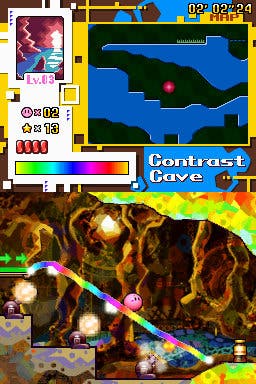Retrospective: Kirby: Canvas Curse
Grand master.
The rainbow lines act like travelators, guiding the pink ball where you'd like him to go. Swoosh a looping path and he'll roll along that, combining his own inertia with gravity, letting you flip and sweep him where you'd like him to be. It's elegant, and it's unique.
Your other mode of interaction is tapping on enemies. Again, you can't do much here - merely stun them by poking at them. When stunned Kirby can roll into them for the kill. Many enemies will then pass on their special power to your pink friend, letting him turn into a missile, or a heavy hexagonal block, or a super-fast wheel, and so on.
Occasionally a specific power will be necessary for reaching a certain area, and thus collecting one of each area's coins. Along with gathering stars that garner you extra lives, coins are the only other significant collectable, exchanged for bonuses from the menu's 'shop'.
So there it all is, the premise, the interaction. Does it still stand up today? Or has the DS become so familiar that this is now the norm, not something quite so astounding?
I think that there has certainly been a slight edge of novelty removed. Not necessarily through repetition of the game's techniques - if anything it's a great shame more copying hasn't taken place, let alone that there's not been a sequel in the same format.

But more because we're quite used to the DS now, to drawing a line and seeing its effects on the world. And we can draw lines on our iPhone too. And probably our kettle. However, there's another hugely significant ingredient here: the speed.
I've had a head cold throughout my time replaying the game. My eyes ache, my nose stings, I'm heavy with the weight of it. And Kirby could not be a better game for such a time. It's just so slow. So perfectly slow.
It's a remarkably contrary way for a platform game. Canvas Curse just wants you to take your time. There's no rush. Nothing's going anywhere. Most of the big, sprawling levels are packed with secret areas, extra bonuses, multiple routes, and even alternative exits. No clock counts down, no ability runs out.
The borderline lackadaisical approach gives you space and time to create the painted routes you wish to take, explore the top-left corner you might want to visit, and never starts nagging you to reach the goal.
This doesn't mean it isn't ever tricky - while certainly an easy game, later stages offer some decent challenges. However, there are a very few levels which do put pressure on you, either scrolling the screen from the left or below, and these stand out as by far the poorest moments. They're the levels that don't get it.
For those wanting the speed trials, any completed area goes into the game's Rainbow Run area, letting you attempt to score best times, or using minimal amounts of ink, so that's all in there too. But the game is at its best when it's just taking its sweet time.
Flopped in bed, lethargic and snotty, it's a perfect accompaniment. The magic is certainly still there five years on.
